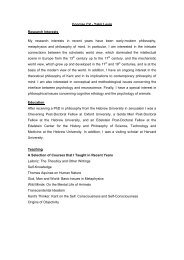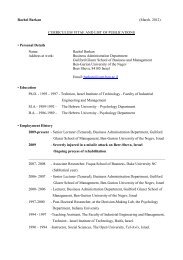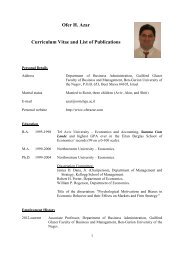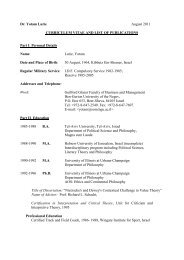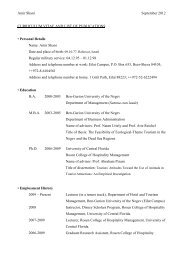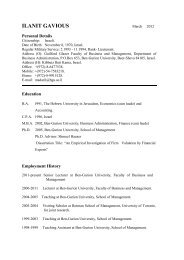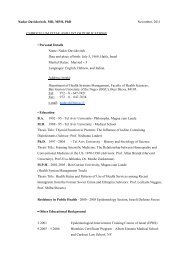Book of Abstracts
Book of Abstracts
Book of Abstracts
Create successful ePaper yourself
Turn your PDF publications into a flip-book with our unique Google optimized e-Paper software.
Patch-size distribution <strong>of</strong> dwarf shrubs in a semiarid grazing land under different soil moisture<br />
conditions<br />
Tal Svoray 1 - tsvoray@bgu.ac.il, Shai Sela 1 and Shmuel Assouline 2<br />
1 Geography and Environmental Development, Ben-Gurion University <strong>of</strong> the Negev, Beer Sheva, Israel<br />
2 Environmental Physics and Irrigation, Agricultural Research Organization; Bet Dagan, Israel<br />
16<br />
Climate-vegetation interactions and feedbacks are the subject <strong>of</strong> many rangeland studies, and recently, the rainfallplant-soil<br />
interplay in the hillslope scale is a focus <strong>of</strong> ecohydrology. As most <strong>of</strong> the models in this scale rely on<br />
synthetic environments, there is a need for studies that use remotely sensed and in-situ data to examine the effect <strong>of</strong><br />
hillslope hydrological processes on ecosystem functioning and plant population spread in a more realistic manner. A<br />
major problem is the difficulty encountered in quantifying water budget and measuring vegetation at the individual<br />
shrub level. In this research, a typical hillslope was chosen, <strong>of</strong>fering variations in slope decline and orientation, soil<br />
depth and vegetation cover, at the LTER Lehavim site in the center <strong>of</strong> Israel. The annual rainfall is 290 mm, the<br />
soils are brown lithosols and arid brown loess, and the dominant rock formations are Eocenean limestone and chalk<br />
with patches <strong>of</strong> calcrete. The vegetation is characterized by scattered dwarf shrubs (dominant species Sarcopoterium<br />
spinosum), and patches <strong>of</strong> herbaceous vegetation, mostly annuals, are spread between rocks and dwarf shrubs. Eight<br />
areal photographs <strong>of</strong> the slope, between the years 1978-2005, were acquired and georeferenced, and shrub cover was<br />
estimated based on the supervised classification <strong>of</strong> the aerial photos. An extensive spatial database <strong>of</strong> soil hydraulic<br />
and environmental parameters (e.g., slope, radiation, bulk density, soil depth) was measured in the field and<br />
interpolated to continuous maps using geostatistical techniques and physically-based modeling. This spatio-temporal<br />
database was used to characterize 1187 spatial cells serving as an input to a numeric hydrological model (Hydrus<br />
1D) solving the flow equations to predict soil water content at the single storm and seasonal scales. The model was<br />
verified by sampling soil moisture at 63 random locations at the research site, during three consecutive storms in the<br />
2008-09 rainy seasons. The results show that shrub-grass ratio reached a steady state phase with 20% cover in 1992<br />
(after 14 yrs). This recovery rate is in agreement with previous field studies. Patch-size distribution in the slope scale<br />
showed that the size <strong>of</strong> patches in the field varies with the soil moisture conditions <strong>of</strong> the last 30 yrs. Quantification<br />
<strong>of</strong> the factors affecting shrub establishment was done using stepwise regression, showing that slope decline,<br />
radiation, soil texture, and rockiness are the leading physical factors.<br />
Carbon Accounting and Minimization in Rural and Dryland<br />
Environments<br />
Elevated carbon emissions among other greenhouse gases have been recognized as a major contributor to<br />
global climate change and there is desire by countries to reduce it. This was reinforced at the recent<br />
Durban conference. Carbon Footprint quantification analysis and reduction are essential to preventing<br />
this change. For example, settlement & landscape design, building design, use <strong>of</strong> appropriate building<br />
materials, enhancing energy efficiency, mitigating carbon emissions by means <strong>of</strong> green energy and/or<br />
compensating for C emissions by carbon <strong>of</strong>fsets preferably within the settlement or village would lead to<br />
carbon neutral regions and ultimately to reducing C emissions. This session invites studies that are<br />
related to carbon accounting, and minimization in rural and arid environments.<br />
Climate change impact on the livelihood <strong>of</strong> farmers<br />
Priscilla M Achakpa-Executive Director, Women Environmental Programme; Abuja, Nigeria;<br />
Priscilla.achakpa@wepnigeria.net<br />
Climate change directly impacts agricultural productivity and food security. This is largely due to the fact that<br />
agricultural productivity depends – to a large extent – on external steady weather patterns. Agriculture is highly<br />
sensitive to climate change, largely because it depends on biodiversity and ecosystems. Sufficient water supplies,<br />
fertile soil, air temperature and average weather conditions all contribute to continuing agricultural productivity.<br />
Once there is a disruption in such patterns, there will be a direct bearing on agricultural output and, for the many



